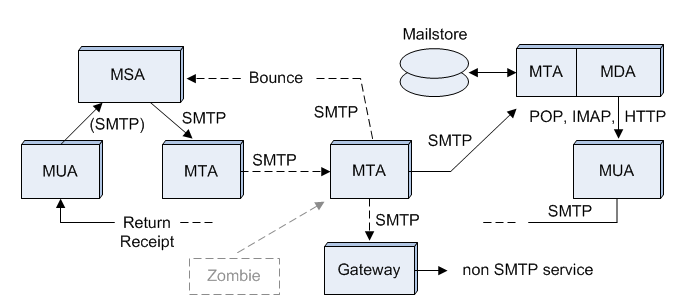User:David MacQuigg/Sandbox/test
Email System Terminology
When a homeopath is conducting an interview to characterise a patient's syndrome of symptoms, some "categories of change" are identified as important:
|
When a homeopath is conducting an interview to characterise a patient's syndrome of symptoms, some "categories of change" are identified as important:
|
Table 1 shows some acronyms commonly used in discussions of email systems. Four of these (MUA, MSA, MTA, and MDA) may be a bit confusing. The confusion arises over the word agent, which is used to mean a process, a program, or a machine, rather than an individual or organization. The use of plain English words like actor and agent to mean something else is common in computer science. This distortion of meaning occurs naturally, as specialists try to be concise in their communications. Instead of saying "MSA process", meaning the process that performs the functions of an agent that handles mail submission, it was easier to just use MSA as an acronym. It works as long as the context is clear.
| Term | Definition |
|---|---|
| MUA | Mail User Agent; a program such as Mozilla Thunderbird, Microsoft Outlook or MUTT that can be used by an Author to compose and send, or by a Recipient to retrieve and read email messages. An MUA can also be a process, such as found in many web browsers or mobile phones. |
| MSA | Message Submission Agent; a machine, program or process that receives messages directly from an MUA, and performs the functions of an Agent responsible for mail submission. |
| MTA | Message Transfer Agent; a Relay; a machine, program or process that receives and stores a message, performs some administrative function, and forwards it to the next Relay or Mailstore. |
| MDA | Message Delivery Agent; the server that accepts mail for a user from a remote MTA and holds it until the user's mail client (their MUA) downloads the message |
| DSN | Delivery Status Notification (aka Bounce); A message generated by any process handling a message in transit, and sent to the Return Address. DSNs are typically sent when a permanent failure occurs in transit. |
| MDN | Message Disposition Notification (aka Return Receipt); A message generated by the recipient's MUA, providing information on post-delivery handling, such as notice that the message has been displayed. |
| SMTP | Simple Mail Transfer Protocol; the protocol used to transfer mail from one mail system to another. Uses port 25 or 587 for unencrypted message transfer. |
| POP | Post Office Protocol; A protocol where a client connects, downloads mail from the server and then deletes that mail from the server. Mail that is downloaded then "sticks" on the computer the user retrieves their mail from. Contrast with IMAP. |
| IMAP | Internet Message Access Protocol; IMAP differs from POP in that messages are left on the server; this allows a user to "float" between different clients at different locations but still have access to all their mail. |
| ADMD | Administrative Management Domain; An individual or organization (user or agent) having operational independence in an email system. |
Table 1 shows some acronyms commonly used in discussions of email systems. Four of these (MUA, MSA, MTA, and MDA) may be a bit confusing. The confusion arises over the word agent, which is used to mean a process, a program, or a machine, rather than an individual or organization. The use of plain English words like actor and agent to mean something else is common in computer science. This distortion of meaning occurs naturally, as specialists try to be concise in their communications. Instead of saying "MSA process", meaning the process that performs the functions of an agent that handles mail submission, it was easier to just use MSA as an acronym. It works as long as the context is clear.
In these articles, we talk about the whole spectrum of "agents", from organizations and individuals to programs and processes, so we can't just use the common jargon without clarification. We also need to make distinctions based on function, like transmitter vs receiver, instead of just calling every relay an MTA.
Figure 2 is the same as Figure 1, but with the processes labeled using the acronyms in Table 1.
Table 1 shows some acronyms commonly used in discussions of email systems. Four of these (MUA, MSA, MTA, and MDA) may be a bit confusing. The confusion arises over the word agent, which is used to mean a process, a program, or a machine, rather than an individual or organization. The use of plain English words like actor and agent to mean something else is common in computer science. This distortion of meaning occurs naturally, as specialists try to be concise in their communications. Instead of saying "MSA process", meaning the process that performs the functions of an agent that handles mail submission, it was easier to just use MSA as an acronym. It works as long as the context is clear.
Table 1 shows some acronyms commonly used in discussions of email systems. Four of these (MUA, MSA, MTA, and MDA) may be a bit confusing. The confusion arises over the word agent, which is used to mean a process, a program, or a machine, rather than an individual or organization. The use of plain English words like actor and agent to mean something else is common in computer science. This distortion of meaning occurs naturally, as specialists try to be concise in their communications. Instead of saying "MSA process", meaning the process that performs the functions of an agent that handles mail submission, it was easier to just use MSA as an acronym. It works as long as the context is clear.
- ↑ 1.0 1.1 Bell IR et al. (2003). "Homeopathic practitioner views of changes in patients undergoing constitutional treatment for chronic disease". J Alt Complement Med 9: 39–50. DOI:10.1089/10762800360520785. PMID 12676034. Research Blogging.
